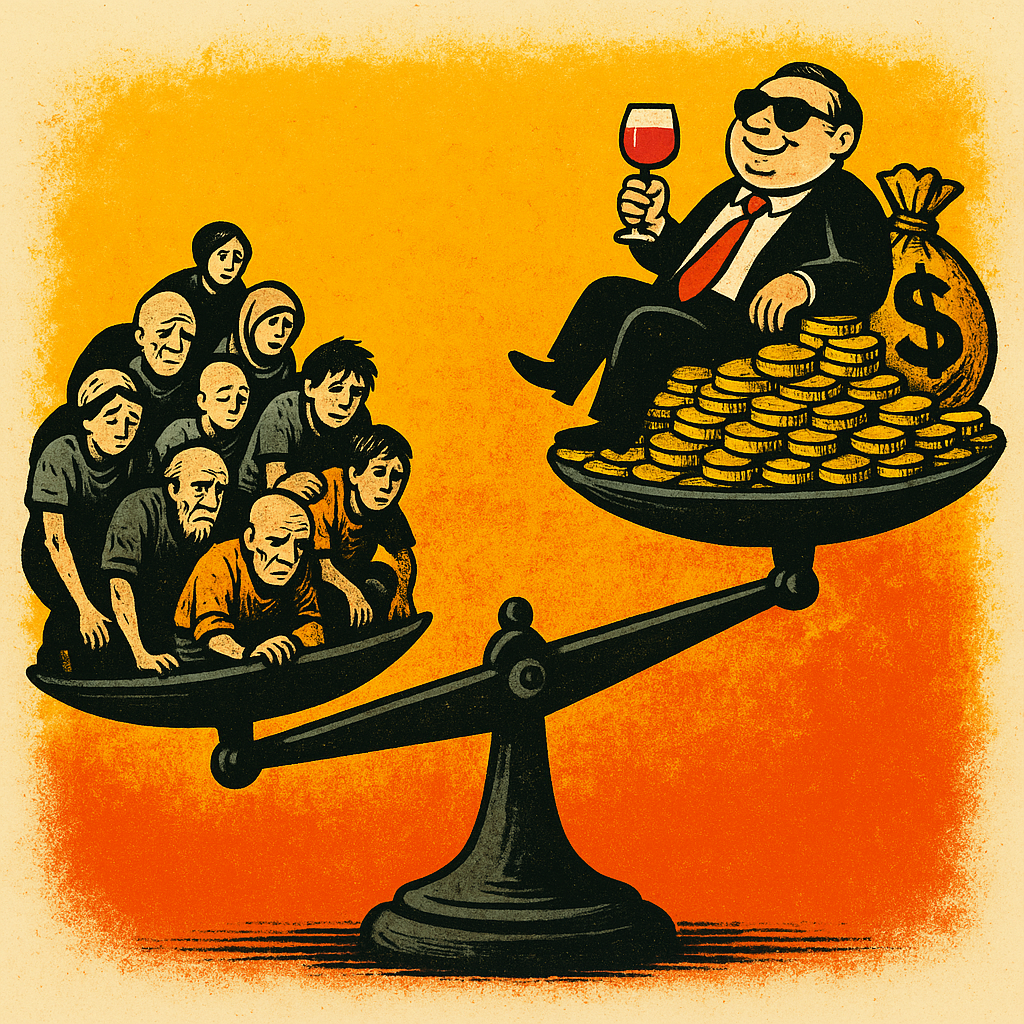Your cart is currently empty!
Who Owns the Wealth in America?
The numbers are staggering.
According to the Federal Reserve’s 2023 Survey of Consumer Finances:
- The top 1% of Americans hold about $44 trillion — roughly 32% of all U.S. wealth.
- The top 10% own nearly 70% of the total wealth.
- Meanwhile, the bottom 50% — about 165 million people — collectively own only 2.5%.
This is a massive concentration of resources in the hands of a tiny few. Wealth here doesn’t just mean money in the bank — it means ownership of assets like stocks, bonds, businesses, real estate, and intellectual property, which generate even more wealth over time.
Where Does This Wealth Go?
Let’s break it down:
- Luxury Consumption: The ultra-wealthy fuel markets for mega-yachts (some costing over $500 million), private jets (with fractional ownership programs like NetJets and Flexjet booming), hyper-expensive art, and private islands.
- Financial Engineering: Billionaires like Jeff Bezos, Warren Buffett, and Elon Musk grow wealth by leveraging stocks, tax-sheltered options, and capital gains, often paying lower effective tax rates than nurses or teachers.
- Corporate Buybacks: In 2023, S&P 500 companies spent over $900 billion on stock buybacks — artificially inflating share prices to enrich executives and shareholders instead of investing in workers, innovation, or social goods.
Evidence of Greed and Disconnection
While millions struggle to pay rent or buy groceries, the richest Americans live in economic bubbles.
Here’s hard evidence:
- Homelessness Crisis: According to the Department of Housing and Urban Development (HUD), over 650,000 people were homeless in 2023 — the highest in recorded history. In cities like Los Angeles and New York, luxury condos sit empty as speculative investments, while families sleep in cars or tents.
- Healthcare Despair: The Kaiser Family Foundation reports over 40 million Americans lack health insurance. Meanwhile, billionaire healthcare investors profit from rising premiums, while GoFundMe says a third of its campaigns are for medical expenses.
- Wage Stagnation: From 1979 to 2020, worker productivity in the U.S. increased by about 60%, but real wages barely budged, rising only about 17%. The difference went to the top: executive compensation skyrocketed, and shareholder profits exploded.
- Tax Avoidance: A 2021 ProPublica investigation revealed billionaires like Bezos, Musk, and Buffett often pay effective federal tax rates under 4% — far less than middle-class families — by borrowing against their assets, not drawing salaries, and exploiting tax loopholes.
Why Is the Gap Growing?
This isn’t happening by accident.
Several systemic factors drive the yawning divide:
✅ Financialization of the Economy
Instead of creating goods or services, the richest Americans increasingly generate wealth from financial speculation — hedge funds, private equity, and algorithmic trading — activities detached from the real economy.
✅ Decline of Organized Labor
Union membership in the U.S. fell from over 20% in 1983 to about 10% today, weakening workers’ power to demand fair wages and benefits. As a result, income growth has heavily favored top earners.
✅ Tax Policy Favoring the Rich
From Reagan’s “trickle-down” tax cuts in the 1980s to Trump’s 2017 Tax Cuts and Jobs Act, the U.S. has repeatedly lowered corporate taxes, capital gains taxes, and estate taxes — concentrating wealth among those already rich.
✅ Asset Inflation
The value of stocks, real estate, and other assets has surged, rewarding the wealthy who own them, while working-class Americans often cannot afford to invest because they’re drowning in debt or living paycheck to paycheck.
Do the Rich Care? Where’s the Help?
It’s not that no billionaires give to charity — but often, philanthropy serves as reputation management or tax strategy:
- Jeff Bezos pledged $10 billion to fight climate change — after Amazon’s carbon footprint rose by nearly 40% in two years and the company busted unions trying to secure better warehouse conditions.
- Billionaire foundations like the Gates Foundation direct billions to global health, but critics note they often prioritize pet projects over systemic change or use charity to exert disproportionate influence over public policy.
- The ultra-rich are known to set up donor-advised funds, which let them get immediate tax write-offs while leaving the money unspent — sometimes for years.
Meanwhile, at the street level, mutual aid networks, small nonprofits, and overworked government programs carry the real burden of helping struggling Americans — often with tiny budgets compared to a single billionaire’s yacht.
What Happens if This Continues?
The U.S. is approaching dangerous inequality levels historically linked to social unrest, political instability, and economic collapse.
- Nobel laureate economist Joseph Stiglitz warns that extreme inequality undermines democracy, concentrates political power, and leaves the masses feeling abandoned.
- A 2020 Pew Research survey found that 61% of Americans believe there’s too much economic inequality, yet many don’t believe the system can be changed.
- As wealth concentrates, social mobility collapses — making the so-called “American Dream” a myth for most.
Final Reckoning: What’s It Going to Take?
The richest Americans didn’t get here alone:
They benefited from public infrastructure, taxpayer-funded research, government stability, and workers who supported their industries. Yet when it’s time to give back meaningfully, they mostly shrug.
If the U.S. wants to survive this widening gulf, it needs:
- Fairer taxes that close loopholes and make the ultra-rich pay their share.
- Living wages and worker protections to lift up the bottom half.
- Investment in public goods — healthcare, education, housing — rather than luxury bubbles for the elite.
- Political reform to limit money’s influence over government decisions.
Otherwise, the U.S. risks becoming a country where a tiny aristocracy rules over a sea of hopeless, angry, and abandoned citizens — and history shows that’s never stable for long.


Leave a Reply